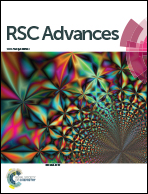The splice variant Ehm2/1 in breast cancer MCF-7 cells interacted with β-catenin and increased its localization to plasma membrane†
Abstract
Ehm2, which belongs to the FERM superfamily, is a metastasis-associated protein. However, its function in cancer metastasis and the associated molecular mechanism is not definitely clear. Alternative splicing is an important biological step during mRNA processing and has been reported to be related with many diseases including cancers. Ehm2 has two transcript variants. Transcript variant 1(Ehm2/1) encodes isoform 1 of 518 amino acids, while transcript variant 2(Ehm2/2) encodes isoform 2 of 913 amino acids. In this study, we found that Ehm2/1 was the main transcript variant in the MCF-7 breast cancer cell line. Forced expression of Ehm2/1 upregulated the total protein amount but had no effect on the mRNA levels of β-catenin. The increased β-catenin was found to be dominantly located at the cell membrane. Meanwhile, knockdown of Ehm2/1 in MCF-7 cells decreased the total protein amount but not the mRNA levels of β-catenin. Further results showed that Ehm2/1 interacted with β-catenin and colocalized with it at the cell membrane. E-cadherin, a partner of β-catenin in cadherin-catenin complexes, was also upregulated by the overexpression of Ehm2/1 and also colocalized with it at the cell membrane. Meanwhile, overexpression of Ehm2/1 inhibited the migration ability of MCF-7 cells. These results suggested that Ehm2/1 may render β-catenin at the cell membrane by interacting with β-catenin and E-cadherin.


 Please wait while we load your content...
Please wait while we load your content...